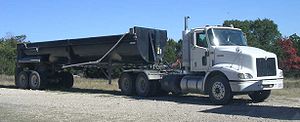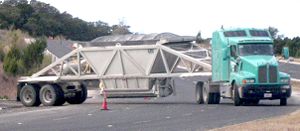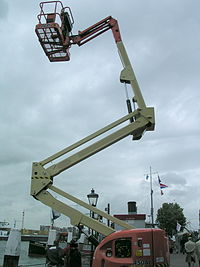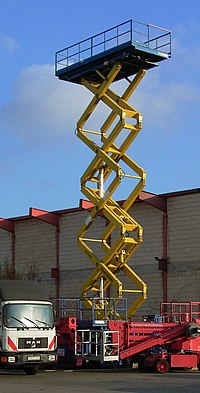
A modern John Deere 8110 Farm Tractor plowing a field using a chisel plow.
The most common use of the term is for the vehicles used on farms. The farm tractor is used for pulling or pushing agricultural machinery or trailers, for plowing, tilling, disking, harrowing, planting, and similar tasks. Charles City, Iowa is the birthplace of the farm tractor in the early 1900's by the Hart-Parr Company,[citation needed] Later sold to White Tractor.
History
The first powered farm implements in the early 1800s were portable engines – steam engines on wheels that could be used to drive mechanical farm machinery by way of a flexible belt. Around 1850, the first traction engines were developed from these, and were widely adopted for agricultural use. Where soil conditions permitted, like the US, steam tractors were used to direct-haul ploughs, but in the UK, ploughing engines were used for cable-hauled ploughing instead. Steam-powered agricultural engines remained in use well into the 20th century, until reliable internal combustion engines had been developed.
In 1892, John Froelich built the first practical gasoline-powered tractor in Clayton County, Iowa. Only two were sold, and it was not until 1911, when the Twin City Traction Engine Company developed the design, that it became successful.
In Britain, the first recorded tractor sale was the oil-burning Hornsby-Ackroyd Patent Safety Oil Traction engine, in 1897. However, the first commercially successful design was Dan Albone's three-wheel Ivel tractor of 1902. In 1908, Saundersons of Bedford introduced a four-wheel design, and went on to become the largest tractor manufacturer outside the USA.
While unpopular at first, these gasoline-powered machines began to catch on in the 1910s when they became smaller and more affordable. Henry Ford introduced the Fordson, the first mass-produced tractor in 1917. They were built in the U.S., Ireland, England and Russia and by 1923, Fordson had 77% of the U.S. market. The Fordson dispensed with a frame, using the strength of the engine block to hold the machine together. By the 1920s, tractors with a gasoline-powered internal combustion engine had become the norm.
The classic farm tractor is a simple open vehicle, with two very large driving wheels on an axle below and slightly behind a single seat (the seat and steering wheel consequently are in the center), and the engine in front of the driver, with two steerable wheels below the engine compartment. This basic design has remained unchanged for a number of years, but enclosed cabs are fitted on almost all modern models, for reasons of operator safety and comfort.
Originally, plows and other equipment were connected via a draw-bar, or a proprietary connecting system; prior to Harry Ferguson patenting the three-point hitch. Recently, Bobcat's patent on its front loader connection has expired; and compact tractors are now being outfitted with quick-connect attachments for their front-end loaders.
There are also lawn tractors. Cub Cadet, Husqvarna, John Deere, Massey Ferguson and Toro are some of the better-known brands.
Operation

A small red tractor towing a cargo cart
Modern farm tractors usually have five foot-pedals for the operator on the floor of the tractor. The pedal on the left is the clutch. The operator presses on this pedal to disengage the transmission for either shifting gears or stopping the tractor. Two of the pedals on the right are the brakes. The left brake pedal stops the left rear wheel and the right brake pedal does the same with the right side. This independent left and right wheel braking augments the steering of the tractor when only the two rear wheels are driven. This is usually done when it is necessary to make a tight turn. The split brake pedal is also used in mud or soft dirt to control a tire that spins due to loss of traction. The operator presses both pedals together to stop the tractor. For tractors with additional front-wheel drive, this operation often engages the 4-wheel locking differential to help stop the tractor when travelling at road speeds.
A fifth pedal just in front of the seat operates the rear differential lock (diff lock) which prevents wheelslip. The differential allows the outside wheel to travel faster than the inside one during a turn. However, in traction conditions on a soft surface the same mechanism could allow one wheel to slip, thus preventing traction to the other wheel. The diff lock overrides this, causing both wheels to supply equal traction. Care must be taken to unlock the differential, usually by hitting the pedal a second time, before turning, since the tractor cannot perform a turn with the diff lock engaged.
The pedal furthest to the right is the foot throttle. Unlike in automobiles, it can also be controlled from a hand-operated lever ("hand throttle"). This helps provide a constant speed in field work. It also helps provide continuous power for stationary tractors that are operating an implement by shaft or belt. The foot throttle gives the operator more automobile-like control over the speed of the tractor for road work. This is a feature of more recent tractors; older tractors often did not have this feature. In the UK it is mandatory to use the foot pedal to control engine speed while travelling on the road. Some tractors, especially those designed for row-crop work, have a 'de-accelerator' pedal, which operates in the reverse fashion to an automobile throttle, in that the pedal is pushed down to slow the engine. This is to allow fine control over the speed of the tractor when maneuvering at the end of crop rows in fields- the operating speed of the engine is set using the hand throttle, and if the operator wishes to slow the tractor to turn, he simply has to press the pedal, turn and release it once the turn is completed, rather than having to alter the setting of the hand throttle twice during the maneuver.
Power and transmission
Modern farm tractors employ large diesel engines, which range in power output from 18 to 575 horsepower (15 to 480 kW). Tractors can be generally classified as two-wheel drive, two-wheel drive with front wheel assist, four-wheel drive (often with articulated steering), or track tractors (with either two or four powered rubber tracks). Variations of the classic style include the diminutive lawn tractors and their more capable and ruggedly constructed cousins, garden tractors, that range from about 10 to 25 horsepower (7.5-18.6 kW) and are used for smaller farm tasks and mowing grass and landscaping. Their size—especially with modern tractors—and the slower speeds are reasons motorists are urged to use caution when encountering a tractor on the roads.
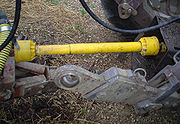
A PTO shaft connected to a tractor.
Most tractors have a means to transfer power to another machine such as a baler, slasher or mower. Early tractors used belts wrapped around a flywheel to power stationary equipment. Modern tractors use a power take-off (PTO) shaft to provide rotary power to machinery that may be stationary or pulled. Almost all modern tractors can also provide external hydraulic fluid and electrical power.
Most farm tractors use a manual transmission. They have several sets of gear ratios divided into speeds. In order to change the ratio, it is usually necessary to stop the tractor. Between them they provide a range of speeds from less than one mile per hour suitable for working the land, up to about 25 miles per hour (40 km/h) for road use. Furthermore it is usually not necessary to change gear in order to reverse, one simply selects a lever. Older tractors usually require that the operator depress the clutch in order to shift between gears (a limitation of straight-cut gears in the gearbox), but many modern tractors have eliminated this requirement with the introduction of technologies such as power shifting in the 1960s and more modern continuously variable transmissions. This allows the operator more and easier control over working speed than the throttle alone could provide.
Slow, controllable speeds are necessary for most operations that are performed with a tractor. They help give the farmer a larger degree of control in certain situations, such as field work. However, when travelling on public roads, the slow operating speeds can cause problems, such as long queues or tailbacks, which can delay or aggravate other road users. To alleviate conditions, some countries (for example the Netherlands) employ a road sign on some roads that means "no farm tractors". Some modern tractors, such as the JCB Fastrac, are now capable of much more tolerable road speeds of around 50 mph (80 km/h).
Safety
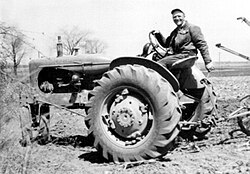
The classic Row Crop tractor (an Allis-Chalmers WD). Note the absence of any rollover protection system.
Agriculture in the United States is one of the most hazardous industries, only surpassed by mining and construction. No other farm machine is so identified with the hazards of production agriculture as the tractor. Tractor related injuries account for approximately 32% of the fatalities and 6% of the non-fatal injuries in agriculture. Over 50% is attributed to tractor overturns.
The roll over protection structure(ROPS) and seat belt, when worn, are the two most important safety devices to protect operators from death during tractor overturns.
Modern tractors have rollover protection systems (ROPS) to prevent an operator from being crushed if the tractor overturns. It is important to remember that the ROPS does not prevent tractor overturns. Rather, it prevents the operator from being crushed during an overturn. This is especially important in open-air tractors, where the ROPS is a steel beam that extends above the operator's seat. For tractors with operator cabs, the ROPS is part of the frame of the cab. A ROPS with enclosed cab further reduces the likelihood of serious injury because the operator is protected by the sides and windows of the cab.
ROPS were first required by legislation in New Zealand in the 1960s (in Sweden, summer of 1959). Before ROPS were required, some farmers died when their tractors rolled on top of them. Row-crop tractors, before ROPS, were particularly dangerous because of their 'tricycle' design with the two front wheels spaced close together and angled inward toward the ground. Some farmers were killed by rollovers while operating tractors along steep slopes. Others have been killed while attempting to tow or pull an excessive load from above axle height, or when cold weather caused the tires to freeze down, in both cases causing the tractor to pivot around the rear axle.
For the ROPS to work as designed, the operator must stay within the protective frame of the ROPS. This means the operator must wear the seat belt. Not wearing the seat belt may defeat the primary purpose of the ROPS.

Farm tractor rear turnover
Applications

An unusual application - road roller powered by a tractor-drive
Farm implements can be attached to the rear of the tractor by either a drawbar or a three-point hitch. The three-point hitch was invented by Harry Ferguson and has been standard since the 1960s. Equipment attached to the three-point hitch can be raised or lowered hydraulically with a control lever. The equipment attached to the three-point hitch is usually completely supported by the tractor. Another way to attach an implement is via a Quick Hitch, which is attached to the three-point hitch. This enables a single person to attach an implement quicker and put the person in less danger when attaching the implement.
Some farm-type tractors are found elsewhere than on farms: with large universities' gardening departments, in public parks or for highway workman use with blowtorch cylinders strapped to its sides and a pneumatic drill air compressor permanently fastened over its power take-off. These are often fitted with grass (turf) tyres which are less damaging to soft surfaces than agricultural tyres.
Supposedly, I4 (industrial bar tires) are less damaging to lawns and soft surfaces than agricultural tires, but provide similar traction, and have the benefit of being self-cleaning. Often, these can be seen on road construction backhoes.
Precision agriculture
Space technology has found its way down to agriculture in the form of GPS devices, and robust on-board computers installed as optional features on farm tractors. These technologies are used in modern, precision farming techniques. The spin-offs from the space race have actually facilitated automation in plowing and the use of autosteer systems drone on tractors that are manned but only steered at the end of a row, the idea being to neither overlap and use more fuel nor leave streaks when performing jobs such as cultivating.
Compact Utility Tractor

Kubota and New Holland Compact Tractors equipped with Front End Loaders
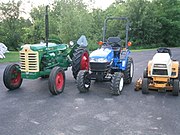
In the middle is a 24 hp (18 kW) diesel CUT illustrating the size difference between a small farm tractor and a garden tractor
A Compact Utility Tractor, also called a CUT is a smaller version of an agricultural tractor but designed primarily for landscaping and estate management type tasks rather than for planting and harvesting on a commercial scale. Typical CUTs range in from 20 to 50 horsepower (15-37 kW) with available power take off (PTO) horsepower ranging from 15 to 45 hp (11-34 kW). CUTs are often equipped with both a mid-mounted PTO and a standard rear PTO, especially those below 40 horsepower (30 kW). The mid-mount PTO shaft typically rotates at/near 2000 rpms and is typically used to power such implements as mid-mount finish mower, a front mounted snow blower or front mounted rotary broom. The rear PTO is standardized at 540 rpms for the North American markets, but in some parts of the world a dual 540/1000 rpm PTO is standard and implements are available for either standard in those markets.

Howse brand modular Subsoiler mounted to a tractor

Broadcast seeder mounted to a Kubota Compact Utility Tractor
One of the most common attachment for a Compact Utility Tractor is the front end loader or FEL. Like the larger agricultural tractors, a CUT will have an adjustable three-point hitch that is hydraulically controlled. Typically a CUT will have four wheel drive, or more correctly 4 wheel assist. Modern Compact Utility Tractors often feature a Hydrostatic transmission, but many variants of gear drive transmissions are also offered from low priced simple gear transmissions to synchronized transmissions to advanced glide-shift transmissions. All modern CUTs feature a government mandated roll over protection structure (ROPS) just like agricultural tractors. The most well known brands in North America include Kubota, John Deere Tractor, New Holland Ag, Case-Farmall and Massey-Ferguson. Although less common, compact backhoes are often attached to compact utility tractors.
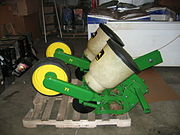
JD 71 Flexi Planter for tractors 20 to 35 horsepower
Compact Utility Tractors require special smaller implements than full size agricultural tractors. Very common implements include the box blade, the grader blade, the landscape rake, the post hole digger (or post hole auger), the rotary cutter (also called a slasher or a brush hog), a mid or rear mount finish mower, broadcast seeder, subsoiler and the rototiller (also rotary tiller). In northern climates, a rear mounted snow blower is very common, on smaller CUTs some models are available with front mounted snow blowers that are powered by a mid-PTO shaft. There are many more implement brands than there are tractor brands offering CUT owners a wide selection of choice.
For small scale farming or large scale gardening, there are some plating and harvesting implements sized for CUTs. One and two row planting units are commonly available as are cultivators, sprayers and different types of seeders (slit, rotary and drop).
Backhoe loader
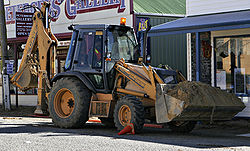
A common backhoe-loader. The backhoe is on the left, the bucket/blade on the right.
The most common variation of the classic farm tractor is the hoe, also called a hoe-loader. As the name implies, it has a loader assembly on the front and a backhoe on the back. Backhoes attach to a 3 point hitch on farm or industrial tractors. Industrial tractors are often heavier in construction particularly with regards to the use of steel grill for protection from rocks and the use of construction tires. When the backhoe is permanently attached, the machine usually has a seat that can swivel to the rear to face the hoe controls. Removable backhoe attachments almost always have a separate seat on the attachment.
Backhoe-loaders are very common and can be used for a wide variety of tasks: construction, small demolitions, light transportation of building materials, powering building equipment, digging holes,loading trucks, breaking asphalt and paving roads. Some buckets have a retractable bottom, enabling them to empty their load more quickly and efficiently. Buckets with retractable bottoms are also often used for grading and scratching off sand. The front assembly may be a removable attachment or permanently mounted. Often the bucket can be replaced with other devices or tools.
Their relatively small frame and precise control make backhoe-loaders very useful and common in urban engineering projects such as construction and repairs in areas too small for larger equipment. Their versatility and compact size makes them one of the most popular urban construction vehicles.
In the UK, the word "JCB" is sometimes used colloquially as a genericized trademark for any such type of engineering vehicle, JCB now appears in the Oxford English Dictionary, although it is still treated as a trademark.
Engineering tractors
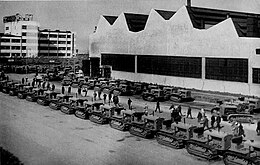
A tractor factory in Chelyabinsk in the Soviet Union circa 1930.
The durability and engine power of tractors made them very suitable for engineering tasks. Tractors can be fitted with engineering tools such as dozer blade, bucket, hoe, ripper, and so on. The most common attachments for the front of a tractor are dozer blade or a bucket. When attached with engineering tools the tractor is called an engineering vehicle.
A bulldozer is a track-type tractor attached with blade in the front and a rope-winch behind. Bulldozers are very powerful tractors and have excellent ground-hold, as their main tasks are to push or drag things.
Bulldozers have been further modified over time to evolve into new machines which are capable of working in ways that the original bulldozer can not. One example is that loader tractors were created by removing the blade and substituting a large volume bucket and hydraulic arms which can raise and lower the bucket, thus making it useful for scooping up earth, rock and similar loose material to load it into trucks.
A front-loader or loader is a tractor with an engineering tool which consists of two hydraulic powered arms on either side of the front engine compartment and a tilting implement. This is usually a wide open box called a bucket but other common attachments are a pallet fork and a bale grappler.
Other modifications to the original bulldozer include making the machine smaller to let it operate in small work areas where movement is limited. There are also tiny wheeled loaders, officially called Skid-steer loaders but nicknamed "Bobcat" after the original manufacturer, which are particularly suited for small excavation projects in confined areas.
Garden Tractors
Garden Tractors (also called Mini Tractors) are small, light and simple tractors designed for use in domestic gardens. Garden Tractors are usually designed primarily for cutting grass, being fitted with horizontal rotary cutting decks. The distinction between a garden tractor and a ride-on lawnmower is often hard to make- generally Garden Tractors are more sturdily built, with stronger frames, axles and transmissions. Garden Tractors are generally capable of mounting other implements such as harrows, cultivators/rotavators, sweepers, rollers and dozer-blades. Like ride-on mowers, Garden Tractors generally have a horizontally-mounted engine with a belt-drive to a transaxle-type transmission (usually of 4- or 5-speeds, although some my also have two-speed reduction gearboxes or hydraulic gearboxes). However, Wheel Horse (now part of Toro) garden tractors have vertically-mounted engines with belt-drive, whilst Allen/Gutbrod tractors had an automotive-type clutch and gearbox. The engines are generally 1- or 2-cylinder petrol (gasoline) engine, although diesel engine models are also available, especially in Europe.
In the U.S., the term riding lawn mower today refers to mid or rear engined machines. Front-engined tractor layout machines designed primarily for cutting grass and light towing are called lawn tractors, and heavy duty lawn tractors, often shaft driven, are garden tractors. The primary difference between a lawn tractor and a garden tractor are the frame weight, the rear wheels (garden tractors almost always have multiple mounting bolts, while most lawn tractors have a single bolt or clip on the hub.), and the ability to use ground engaging equipment such as plows or disk-harrows. Craftsman, MTD, Snapper and other major mowing equipment manufacturers use these terms.
As well as dedicated manufacturers, many makers of agricultural tractors have made (or continue to make) ranges of garden tractors, such as Case, Massey-Ferguson, International Harvester and John Deere.
EPA tractor

A Ford rebuilt to an EPA tractor.

A Volvo Duett rebuilt to an EPA tractor. Obviously the intended use is no longer as a farm vehicle.

An "A tractor" based on Volvo 760. Notice the slow vehicle triangle and the longer boot.
During World War II there was a shortage of tractors in Sweden and this led to the invention of a new type of tractor called the EPA tractor (EPA was a chain of discount stores and it was often used to signify something lacking in quality). An EPA tractor was simply an automobile, truck or lorry, with the passenger space cut off behind the front seats, equipped with two gearboxes in a row. When done to an older car with a ladder frame, the result was not dissimilar to a tractor and could be used as one.
After the war it remained popular, now not as a farm vehicle, but as a way for young people without a driver's license to own something similar to a car. Since it was legally seen as a tractor it could be driven from 16 years of age and only required a tractor license. Eventually the legal loophole was closed and no new EPA tractors were allowed to be made, but the remaining were still legal, something that led to inflated prices and many protests from people that preferred EPA tractors to ordinary cars.
In March 31, 1975 a similar type of vehicle was introduced, the A tractor [from arbetstraktor (work tractor)]. The main difference is that an A tractor has a top speed of 30 km/h. This is usually done by fitting two gearboxes in a row and not using one of them. Volvo Duett was for a long time the primary choice for conversion to an EPA or A tractor, but, since supplies have dried up, other cars have been used, in most cases a Volvo.




